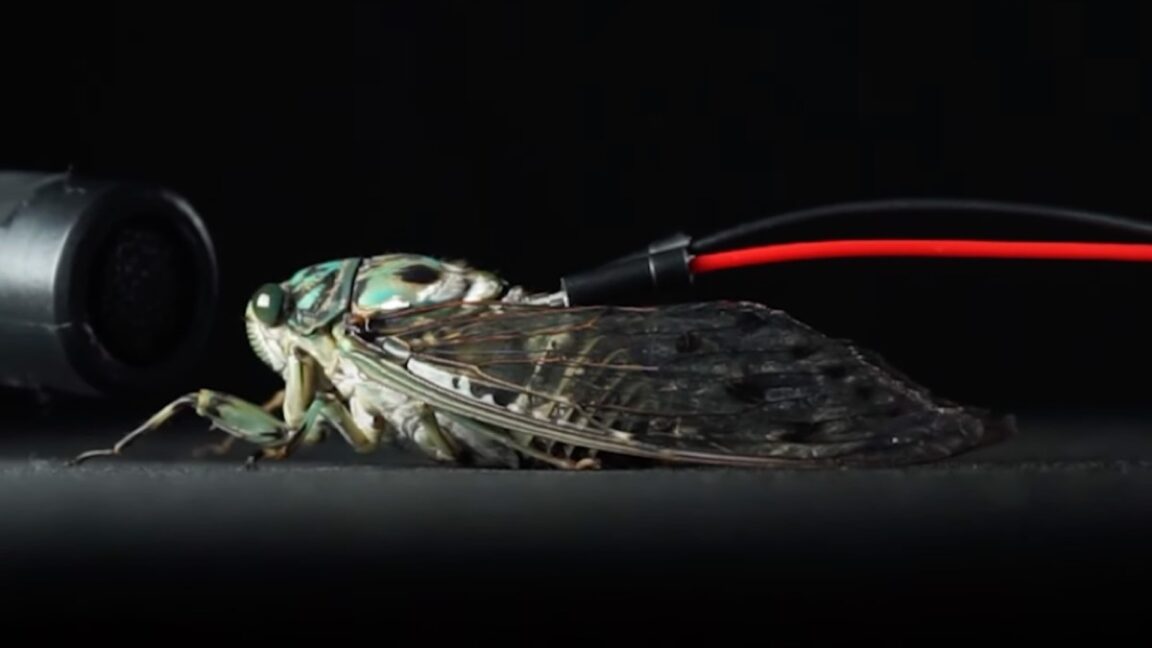I, cyborg
Cyborg cicadas play Pachelbel’s Canon
Such insect-computer hybrid speakers might one day be used to transmit warnings in emergencies.
Jennifer Ouellette
–
May 2, 2025 12:15 pm
|
19
Credit:
University of Tsukuba
Credit:
University of Tsukuba
Text
settings
Story text
Size
Small
Standard
Large
Width
*
Standard
Wide
Links
Standard
Orange
* Subscribers only
Learn more
Minimize to nav
The distinctive chirps of singing cicadas are a highlight of summer in regions where they proliferate; those chirps even featured prominently on Lorde's 2021 album Solar Power. Now, Japanese scientists at the University of Tsukuba have figured out how to transform cicadas into cyborg insects capable of "playing" Pachelbel's Canon. They described their work in a preprint published on the physics arXiv. You can listen to the sounds here.
Scientists have been intrigued by the potential of cyborg insects since the 1990s, when researchers began implanting tiny electrodes into cockroach antennae and shocking them to direct their movements. The idea was to use them as hybrid robots for search-and-rescue applications.
For instance, in 2015, Texas A&M scientists found that implanting electrodes into a cockroach's ganglion (the neuron cluster that controls its front legs) was remarkably effective at successfully steering the roaches 60 percent of the time. They outfitted the roaches with tiny backpacks synced with a remote controller and administered shocks to disrupt the insect's balance, forcing it to move in the desired direction
And in 2021, scientists at Nanyang Technological University in Singapore turned Madagascar hissing cockroaches into cyborgs, implanting electrodes in sensory organs known as cerci that were then connected to tiny computers. Applying electrical current enabled them to steer the cockroaches successfully 94 percent of the time in simulated disaster scenes in the lab.
The authors of this latest paper were inspired by that 2021 project and decided to apply the basic concept to singing cicadas, with the idea that cyborg cicadas might one day be used to transmit warning messages during emergencies. It's usually the males who do the singing, and each species has a unique song. In most species, the production of sound occurs via a pair of membrane structures called tymbals, which are just below each side of the insect's anterior abdominal region. The tymbal muscles contract and cause the plates to vibrate while the abdomen acts as a kind of resonating chamber to amplify the song.
The Tsukuba team essentially hijacked the tymbals of seven large male cicadas of the Graptosaltria nigrofuscata species by attaching electrodes to create their insect-computer hybrid speakers. This species has fewer muscles or organs near the tymbals, making it easier to focus the electrical stimulation on those sound-producing muscles, and its larger size made it easier to perform the necessary surgical procedures.
A user interface sent electrical signals through an amplifier circuit, which enhanced the signals and sent them to the electrodes on the cicadas. Microphones placed one centimeter in front of the insects recorded their chirps in response to the electrical stimulation while a circuit tester measured the voltage flowing through their tiny bodies. The researchers experimented with different voltages to determine the optimal voltages for producing each pitch interval and mapped the resulting waveforms.
After a bit of trial and error, the team induced the cicadas to produce specific musical notes over more than three octaves, ranging from 27.5 hertz to 261.6 hertz. From there, the researchers figured out how to get the insects to "play" recognizable tunes, notably Pachelbel's Canon. The experiments did not harm the cicadas, co-author Naoto Nishida, now at the University of Tokyo, told New Scientist. "Some of them wanted to run away," he said. "Others were like, 'OK, use my abdomen.'"
arXiv, 2025. DOI: 10.48550/arXiv.2504.16459 (About DOIs).
Jennifer Ouellette
Senior Writer
Jennifer Ouellette
Senior Writer
Jennifer is a senior writer at Ars Technica with a particular focus on where science meets culture, covering everything from physics and related interdisciplinary topics to her favorite films and TV series. Jennifer lives in Baltimore with her spouse, physicist Sean M. Carroll, and their two cats, Ariel and Caliban.
19 Comments










